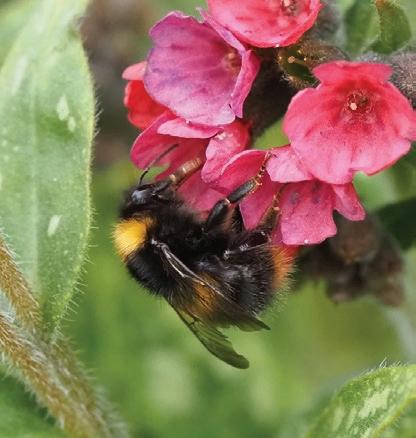
4 minute read
Why protect our pollinators?
Pollinators are declining globally
Along with many other insects, wild pollinators are declining in occurrence and diversity across North-West Europe1,2. A 2006 assessment revealed that across the island, 30 of our 99 bee species are at risk of extinction3. In Britain, declines appear to be bigger in rare species and those that require specific habitat types4. This is of serious concern because of the fundamental role wild pollinators play across natural and managed ecosystems. The majority (78%) of European flowering plant species are animal pollinated5, as are 71 of the 100 crops that provide 90% of the world’s food supply6. In Europe alone, 84% of the 264 crop species are animal pollinated and 4,000 vegetable varieties exist thanks to pollination by bees7,8. Across Europe, crop pollination accounts for nearly €15 billion of the total economic value of crop production per year9. In Ireland, the annual value of animal pollination to homeproduced food crops was recently estimated to be up to €59 million per year10 .
Advertisement
Wider benefits of pollinators
While wild pollinators, through the pollination services they provide, are important for healthy diets, agricultural economies and nutritional security2, they also influence our lives in many more ways – pollinators affect ecosystem structure, processes, and other ecosystem services. Insect-pollinated plant species play important ecological roles, e.g. providing fruits and seeds for birds and other wildlife, contributing to nutrient cycling (e.g. nitrogen fixation), and to climate change adaptation. Furthermore, wild pollinator conservation measures can directly benefit other beneficial taxa, such as natural pest enemies that enhance biological control, and may play an important role in landscapes in terms of microclimate regulation, soil erosion prevention and in creating windbreaks11. Therefore, wild pollinator conservation can represent a winwin solution for tackling both the biodiversity loss and the climate crises.

To protect pollination service, we need to protect as much wild pollinator diversity as possible
Because different wild pollinator species are active at different times of day and at different times of the year; have varying behaviour, body size and tongue length, flight distances, habitat and foraging preferences, and susceptibility to stressors, they vary in the plant species they pollinate. Studies have shown that, around the world, crop pollination and yields increase when there is more diversity of these traits in agricultural systems, when there are more species of pollinators, and when pollinators are more abundant in general12,13. Overall, systems that are more biodiverse tend to be more stable and more resistant to changes in climate14. Thus, it is vital that we conserve as much of our wild pollinator species diversity as possible.
Global initiatives
There has been recent widespread attention and enthusiasm for the protection and conservation of wild pollinators, particularly bees. In 2016, governments around the world approved the Intergovernmental Science-Policy Platform on Biodiversity and Ecosystem Services (IPBES) report on Pollinators, Pollination and Food Production2, which reviewed global value, status, risks and opportunities, and many have joined a global coalition to protect pollinators (www.promotepollinators.org). In 2017, the United
Nations designated May 20th as World Bee Day to a combination of indirect drivers, such as human raise awareness of the importance of pollinators, population growth, urbanisation, agricultural the threats they face, and their contribution intensification, and direct drivers, such as habitat to sustainable development. In 2018, the EU loss, disease, and exposure to toxins19. This established the EU Pollinators Initiative (https:// ongoing decline severely threatens our ability to ec.europa.eu/environment/nature/conservation/ deliver the Sustainable Development Goals, as we species/pollinators/policy_en.htm) to address cannot meet social and economic goals without the decline of wild pollinators in the EU, and to achieving the underpinning environmental goals. contribute to global conservation efforts, and There is an urgent need for effective changes in there have been numerous local, national and policy and behaviour across all sectors, and at a corporate initiatives across Europe15. Public, range of levels, from individual land-managers, political and scientific interest in pollinator local communities, and small and medium Only 21 +1 conservation has popularised the implementation of conservation actions for pollinators in a range of sites, including rural and urban areas16,17 . 77 98= enterprises (SMEs), to national governments, the European Commission and multinational businesses. To reverse pollinator loss, drivers Honeybee Bumblebee Wild bee Solitary bee of decline need to be removed, habitats must species species The global situation remains species speciesbe restored, and the ecological, economic and precarious and the time to act is now societal business cases for action need to be Despite ongoing efforts, and global knowledge gaps with regard to wild pollinator status and trends, most evidence points towards continued recognised. On the island of Ireland, we have started this journey through the first phase of the All-Ireland Pollinator Plan. decline18. This decline is thought to be caused by
Protecting pollinators brings many benefits
Crop pollination
Wild plant pollination Co-benefits
Climate regulation, human health and wellbeing, landcape and culture, stable soil, reduced flood risk
Diversity of pollinators Other benefits
Waste recycling, pest control, prey for insectivores










